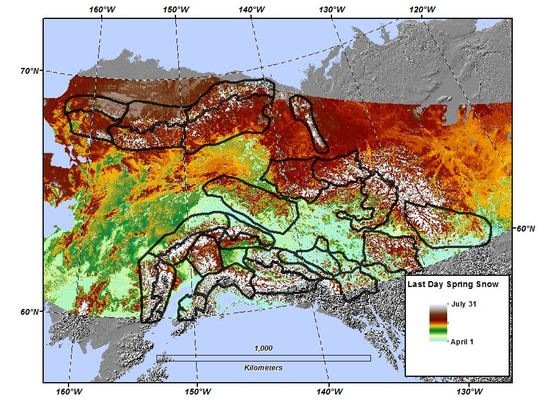Remote Sensing of 2000–2016 Alpine Spring Snowline Elevation in Dall Sheep Mountain Ranges of Alaska and Western Canada
Abstract
:1. Introduction
- Use gridded climate products to estimate winter precipitation and May temperature among 28 major mountain areas in Alaska and northwest Canada.
- Develop 2000–2016 remotely sensed estimates of spring snowline elevation during the typical lambing period of mid-May among the 28 major mountain areas.
- Model mean 2000–2016 spring snowline elevation as a function of decadal mean winter precipitation and mean spring temperature.
- Assess the regional variability of remotely sensed spring snowline during the unusually cold and late spring of 2013.
2. Methods
2.1. Study Region
2.2. Climatic Variation among Mountain Areas
2.3. Elevation Zones
2.4. Remotely Sensed Snow Fraction
2.5. Validation
3. Results
3.1. Comparison of Landsat NDSI and MODSCAG Based Snowline Elevation Estimates
3.2. Mountain Area Climates
3.3. 2000–2016 Mean 15 May Snowline Elevation among Mountain Areas
3.4. Spring 2013 Snowline Elevation among Mountain Areas
4. Discussion
5. Conclusions
Acknowledgments
Author Contributions
Conflicts of Interest
References
- Callaghan, T.V.; Johansson, M.; Brown, R.D.; Groisman, P.Y.; Labba, N.; Radionov, V.; Barry, R.G.; Bulygina, O.N.; Essery, R.L.H.; Frolov, D.M.; et al. The changing face of Arctic snow cover: A synthesis of observed and projected changes. AMBIO 2011, 40 (Suppl. 1), 17–31. [Google Scholar] [CrossRef]
- Ozgul, A.; Childs, D.Z.; Oli, M.K.; Armitage, K.B.; Blumstein, D.T.; Olson, L.E.; Tuljapurkar, S.; Coulson, T. Coupled dynamics of body mass and population growth in response to environmental change. Nature 2010, 466, 482–485. [Google Scholar] [CrossRef] [PubMed]
- Hegel, T.M.; Mysterud, A.; Huettmann, F.; Stenseth, N.C. Interacting effect of wolves and climate on recruitment in a northern mountain caribou population. Oikos 2010, 119, 1453–1461. [Google Scholar] [CrossRef]
- Adams, L.G. Marrow fat deposition and skeletal growth in caribou calves. J. Wildl. Manag. 2003, 67, 20–24. [Google Scholar] [CrossRef]
- Worley, K.; Strobeck, C.; Arthur, S.; Carey, J.; Schwantje, H.; Veitch, A.; Coltman, D.W. Population genetic structure of North American thinhorn sheep (Ovis dalli). Mol. Ecol. 2004, 13, 2545–2556. [Google Scholar] [CrossRef] [PubMed]
- Putkone, J.; Roe, G. Rain-on-snow events impact soil temperatures and affect ungulate survival. Geophys. Res. Lett. 2003, 30. [Google Scholar] [CrossRef]
- Pettorelli, N.; Pelletier, F.; von Hardenberg, A.; Festa-Bianchet, M.; Côté, S.D. Early onset of vegetation growth vs. rapid green-up: Impacts on juvenile mountain ungulates. Ecology 2007, 88, 381–390. [Google Scholar] [CrossRef] [PubMed]
- Alaska Department of Fish and Game. Trends in Alaska Sheep Populations, Hunting, and Harvests. Division of Wildlife Conservation, Wildlife Management Report 2014, ADFG/DWC/WMR-2014-3. Available online: https://www.adfg.alaska.gov/static/home/library/pdfs/wildlife/mgt_rpts/14_sheep_report_bog.pdf (accessed on 24 January 2017).
- Alaska Department of Fish and Game. Dall Sheep Management Report of Survey-Inventory Activities July 2007–June 2010, Project6.0, Harper, P. Editor. Available online: https://www.adfg.alaska.gov/static/home/library/pdfs/wildlife/mgt_rpts/11_sheep.pdf (accessed on 24 January 2017).
- Loehr, J.; Carey, J.; O’Hara, R.B.; Hik, D.S. The role of phenotypic plasticity in responses of hunted thinhorn sheep ram growth to changing climate conditions. J. Evol. Biol. 2010, 23, 783–790. [Google Scholar] [CrossRef] [PubMed]
- Rachlow, J.L.; Bowyer, R.T. Habitat selection by Dall’s sheep (Ovis dalli): Maternal trade-offs. J. Zool. 1998, 245, 457–465. [Google Scholar] [CrossRef]
- Arthur, S.M.; Prugh, L.R. Predator-mediated indirect effects of snowshoe hares on Dall’s sheep in Alaska. J. Wildl. Manag. 2010, 74, 1709–1721. [Google Scholar] [CrossRef]
- Stone, R.S.; Dutton, E.G.; Harris, J.M.; Longenecker, D. Earlier spring snowmelt in northern Alaska as an indicator of climate change. J. Geophys. Res. 2002, 107. [Google Scholar] [CrossRef]
- Brown, R.; Derksen, C.; Wang, L. A multi-data set analysis of variability and change in Arctic spring snow cover extent. J. Geophys. Res. 2010, 115, 1967–2008. [Google Scholar] [CrossRef]
- Šmejkalová, T.; Edwards, M.E.; Dash, J. Arctic lakes show strong decadal trend in earlier spring ice-out. Sci. Rep. 2016, 6, 38449. [Google Scholar] [CrossRef] [PubMed]
- Boyce, M.S.; Haridas, C.V.; Lee, C.T.; The NCEAS Stochastic Demography Working Group. Demography in an increasing variable world. Trends Ecol. Evol. 2006, 21, 141–148. [Google Scholar] [CrossRef] [PubMed]
- Price, M.F.; Byers, A.C.; Kohler, T.; Price, L.W. (Eds.) Mountain Geography: Physical and Human Dimensions; University of California Press: Los Angeles, CA, USA, 2013; p. 396. [Google Scholar]
- Shea, J.M.; Menounos, B.; Moore, R.D.; Tennant, C. An approach to derive regional snow lines and glacier mass change from MODIS imagery, Western North America. Cryosphere 2013, 7, 667–680. [Google Scholar] [CrossRef]
- Dedieu, J.-P.; Carlson, B.Z.; Bigot, S.; Sirguey, P.; Vionnet, V.; Choler, P. On the Importance of High-Resolution Time Series of Optical Imagery for Quantifying the Effects of Snow Cover Duration on Alpine Plant Habitat. Remote Sens. 2016, 8, 481. [Google Scholar] [CrossRef]
- Krajčí, P.; Holko, L.; Perdigão, R.A.; Parajka, J. Estimation of regional snowline elevation (RSLE) from MODIS images for seasonally snow covered mountain basins. J. Hydrol. 2014, 519, 1769–1778. [Google Scholar] [CrossRef]
- Hammond, T.; Yarie, J. Spatial prediction of climatic state factor regions in Alaska. Ecoscience 1996, 3, 490–501. [Google Scholar] [CrossRef]
- Stafford, J.M.; Wendler, G.; Curtis, J. Temperature and precipitation of Alaska: 50 year trend analysis. Theor. Appl. Climatol. 2000, 67, 33–44. [Google Scholar] [CrossRef]
- Fleming, M.D.; Chapin, F.S.; Cramer, W.; Hufford, G.L.; Serreze, M.C. Geographic patterns and dynamics of Alaskan climate interpolated from a sparse station record. Glob. Chang. Biol. 2000, 6, 49–58. [Google Scholar] [CrossRef]
- Olson, D.M.; Dinerstein, E.; Wikramanayake, E.D.; Burgess, N.D.; Powell, G.V.N.; Underwood, E.C.; D’Amico, J.A.; Itoua, I.; Strand, H.E.; Morrison, J.C.; et al. Terrestrial ecoregions of the world: A new map of life on Earth. Bioscience 2001, 51, 933–938. [Google Scholar] [CrossRef]
- Harris, I.; Jones, P.D.; Osborn, T.J.; Lister, D.H. Updated high-resolution grids of monthly climatic observations—the TS3.10 Dataset. Int. J. Climatol. 2014, 34, 62–642. [Google Scholar] [CrossRef] [Green Version]
- Scenario Networks for Alaska and Arctic Planning, University of Alaska. 2016. Available online: https://www.snap.uaf.edu/methods/downscaling (accessed on 24 January 2017).
- Hay, L.E.; Wilby, R.L.; Leavesley, G.H. A comparison of delta change and downscaled GCS scenarios for three mountain basins in the United States. J. Am. Water Res. Assoc. 2000, 35, 387–397. [Google Scholar] [CrossRef]
- Hayhoe, K.A. A Standardized Framework for Evaluating the Skill of Regional Climate Downscaled Techniques. Ph.D. Thesis, University of Illinois, Urbana, IL, USA, 2010. [Google Scholar]
- PRISM Climate Group, Oregon State University, Climate Normal Obtained. Available online: http://www.prism.oregonstate.edu (accessed on 24 January 2017).
- Daly, C.; Halbleib, M.; Smith, J.I.; Gibson, W.P.; Doggett, M.K.; Taylor, G.H.; Curtis, J.; Pasteris, P.P. Pysiographically sensitive mapping of climatological temperature and precipitation across the conterminous United States. Int. J. Climatol. 2008, 28, 2031–2064. [Google Scholar] [CrossRef]
- Simpson, J.J.; Hufford, G.L.; Daly, C.; Berg, J.S.; Fleming, M.D. Comparing maps of mean monthly surface temperature and precipitation for Alaska and adjacent areas of Canada produced by two different methods. Arctic 2005, 58, 137–161. [Google Scholar] [CrossRef]
- Dozier, J. Spectral signature of alpine snow cover from the Landsat Thematic Mapper. Remote Sens. Environ. 1989, 28, 9–22. [Google Scholar] [CrossRef]
- Painter, T.H.; Dozier, J.; Roberts, D.A.; Davis, R.E.; Green, R.O. Retrieval of subpixel snow-covered area and grain size from imaging spectrometer data. Remote Sens. Environ. 2003, 85, 64–77. [Google Scholar] [CrossRef]
- Painter, T.H.; Rittger, K.; McKenzie, C.; Slaughter, P.; Davis, R.E.; Dozier, J. Retrieval of subpixel snow covered area, grain size, and albedo from MODIS. Remote Sens. Environ. 2009, 113, 868–879. [Google Scholar] [CrossRef]
- Rittger, K.; Painter, T.H.; Dozier, J. Assessment of methods for mapping snow cover from MODIS. Adv. Water Res. 2013, 51, 367–380. [Google Scholar] [CrossRef]
- Raliegh, M.S.; Rittger, K.; Moore, C.E.; Henn, B.; Lutz, J.A.; Lundquist, J.D. Ground-based testing of MODIDS fractional snow cover in subalpine meadows and forests of the Sierra Nevada. Remote Sens. Environ. 2013, 128, 44–57. [Google Scholar] [CrossRef]
- Van Soest, P.J. Nutritional Ecology of the Ruminant; Cornell University Press: Corvallis, OR, USA, 1982; p. 374. [Google Scholar]
- Fox, J. Forage Quality of Carex macrochaeta Emerging from Alaskan Alpine Snowbanks through the Summer. Am. Midl. Nat. 1991, 126, 287–293. [Google Scholar] [CrossRef]
- White, R.G. Foraging patterns and their multiplier effects on productivity of northern ungulates. Oikos 1983, 40, 377–384. [Google Scholar] [CrossRef]
- Seip, D.R.; Bunnell, F.L. Nutrition of Stone’s sheep on burned and unburned rages. J. Wildl. Manag. 1985, 49, 397–405. [Google Scholar] [CrossRef]
- Lohuis, T. Ewe Dall Sheep Survival, Pregnancy and Partition Rates, and Lamb Recruitment in GMU 13D, Chugach Mountains, Alaska. Alaska Department of Fish and Game Annual Progress Report, AKW-4 Wildlife Restoration, FY2015, 10pp. Available online: https://www.adfg.alaska.gov/static/home/library/pdfs/wildlife/research_pdfs/6.16_10.pdf (accessed on 24 January 2017).
- Rattenbury, K.; Schmidt, J.; Phillips, L.; Arthur, S.; Borg, B.; Burch, J.; Joly, K.; Lawler, J.; Mangipane, B.; Putera, J. Recent trends in Dall’s sheep populations in Alaska’s National Parks and Preserves. In Proceedings of the Alaska Dall Sheep Working Group Meeting, Anchorage, AK, USA, 20–21 February 2016; Available online: https://www.adfg.alaska.gov/static/regulations/regprocess/gameboard/sheepcomm/pdfs/20160220/6nps.pdf (accessed on 24 January 2017).
- Nippert, J.B.; Knapp, A.K.; Briggs, J.M. Intra-annual rainfall variability and grassland productivity: Can the past predict the future? Plant Ecol. 2006, 184, 65–74. [Google Scholar] [CrossRef]
- Hansen, B.B.; Grøtan, V.; Aanes, R.; Sæther, B.-E.; Stien, A.; Fuglei, E.; Ims, R.A.; Yoccoz, N.G.; Pedersen, Å.Ø. Climate events synchronize the dynamics of a resident vertebrate community in the high arctic. Science 2013, 339, 313–315. [Google Scholar] [CrossRef] [PubMed]
- IPCC. Climate Change 2013: The Physical Science Basis. Contribution of Working Group I to the Fifth Assessment Report of the Intergovernmental Panel on Climate Change; Stocker, T.F., Qin, D., Plattner, G.-K., Tignor, M., Allen, S.K., Boschung, J., Nauels, A., Xia, Y., Bex, V., Midgley, P.M., Eds.; Cambridge University Press: Cambridge, UK, 2013. [Google Scholar]
- Hoefs, M. Twinning in Dall sheep. Can. Field-Nat. 1978, 92, 292–293. [Google Scholar]
- Bunnell, F.L. Factors controlling lambing period of Dall’s sheep. Can. J. Zool. 1980, 58, 1027–1031. [Google Scholar] [CrossRef] [PubMed]
- Rachlow, J.L.; Bowyer, R.T. Variability in maternal behavior by Dall’s Sheep: Environmental tracking or adaptive strategy. J. Mammal. 1994, 75, 323–337. [Google Scholar] [CrossRef]
- Van de Kerk, M.; Verbyla, D.; Nolin, A.W.; Sivy, K.J.; Prugh, L.R. Adverse effects of snow cover on Dall sheep populations increase with latitude. J. Biogeogr. 2016. submitted. [Google Scholar]
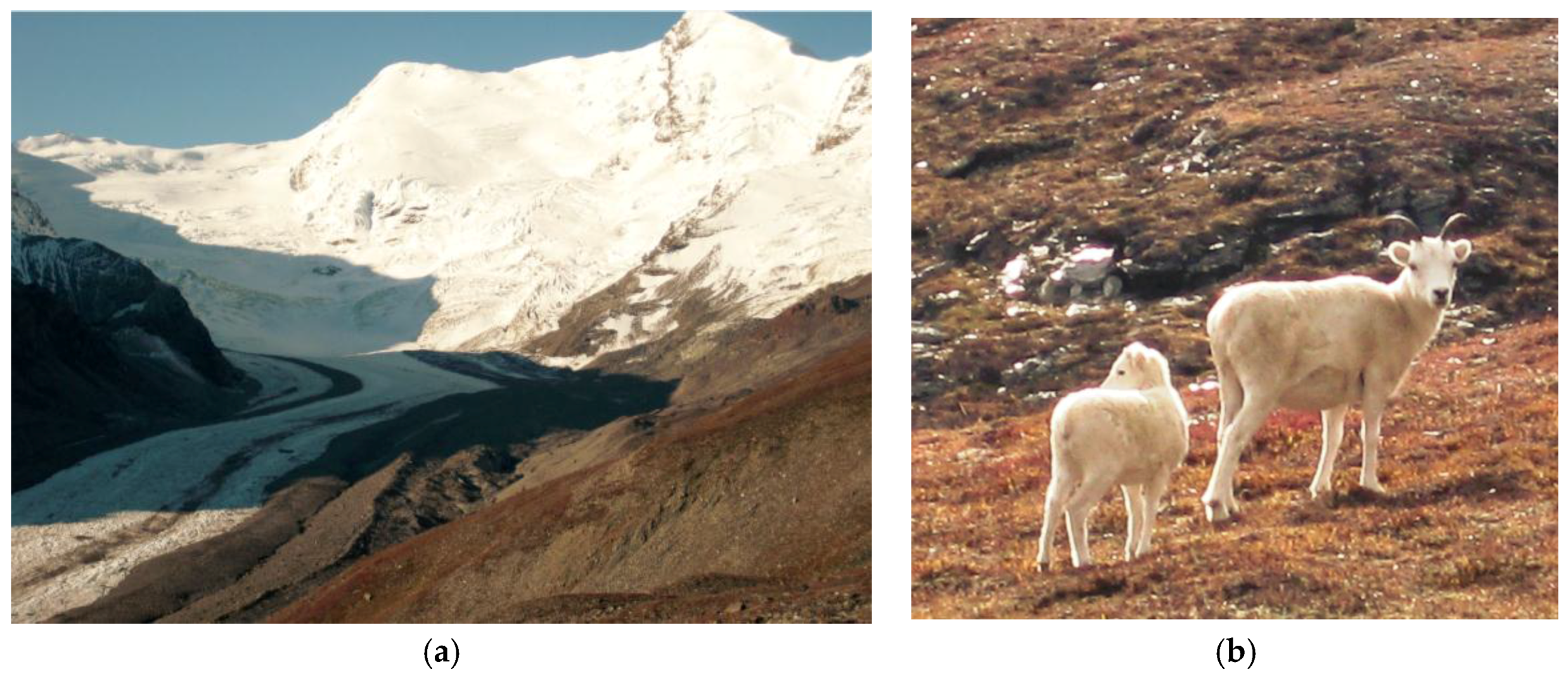
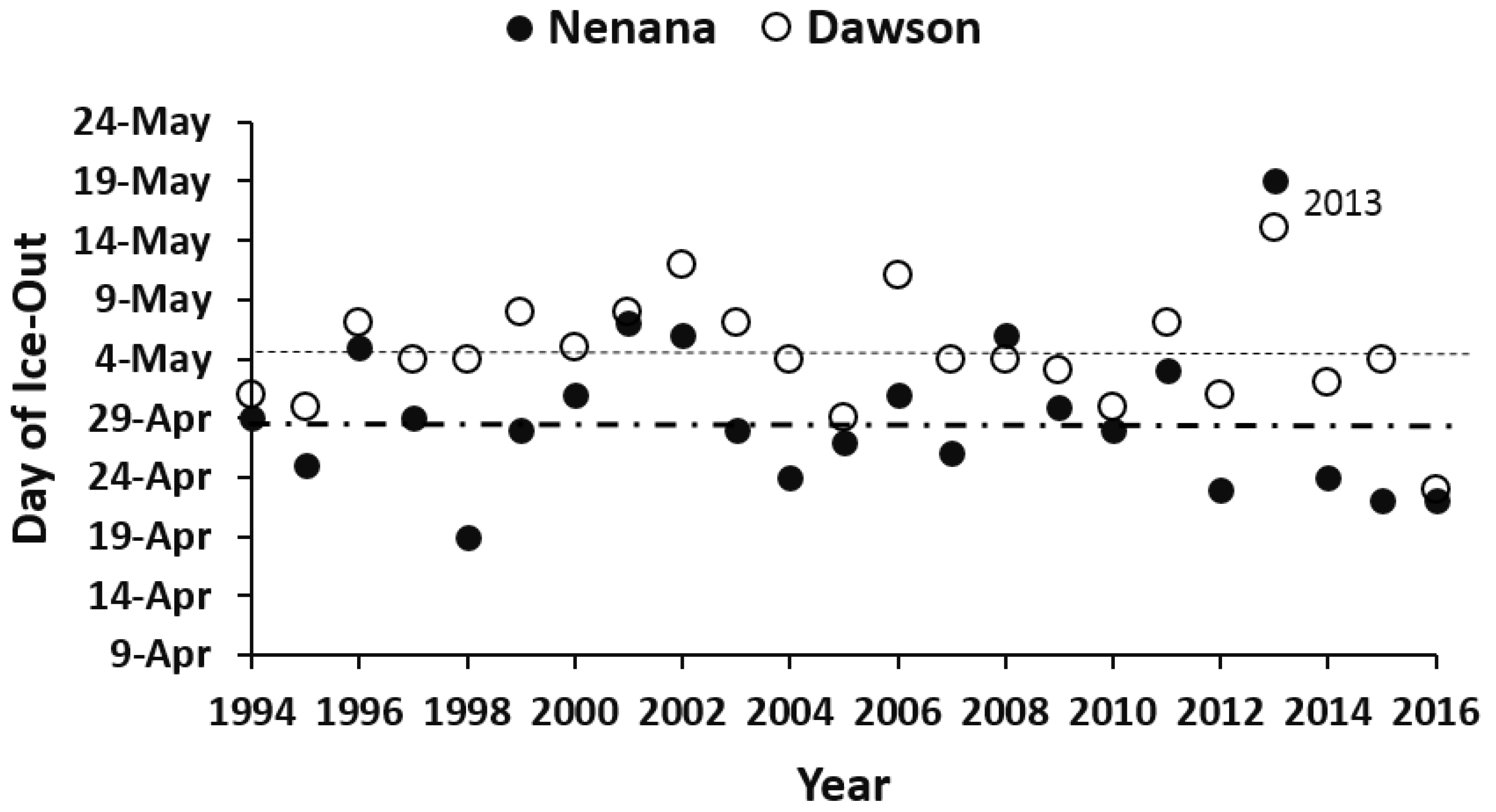
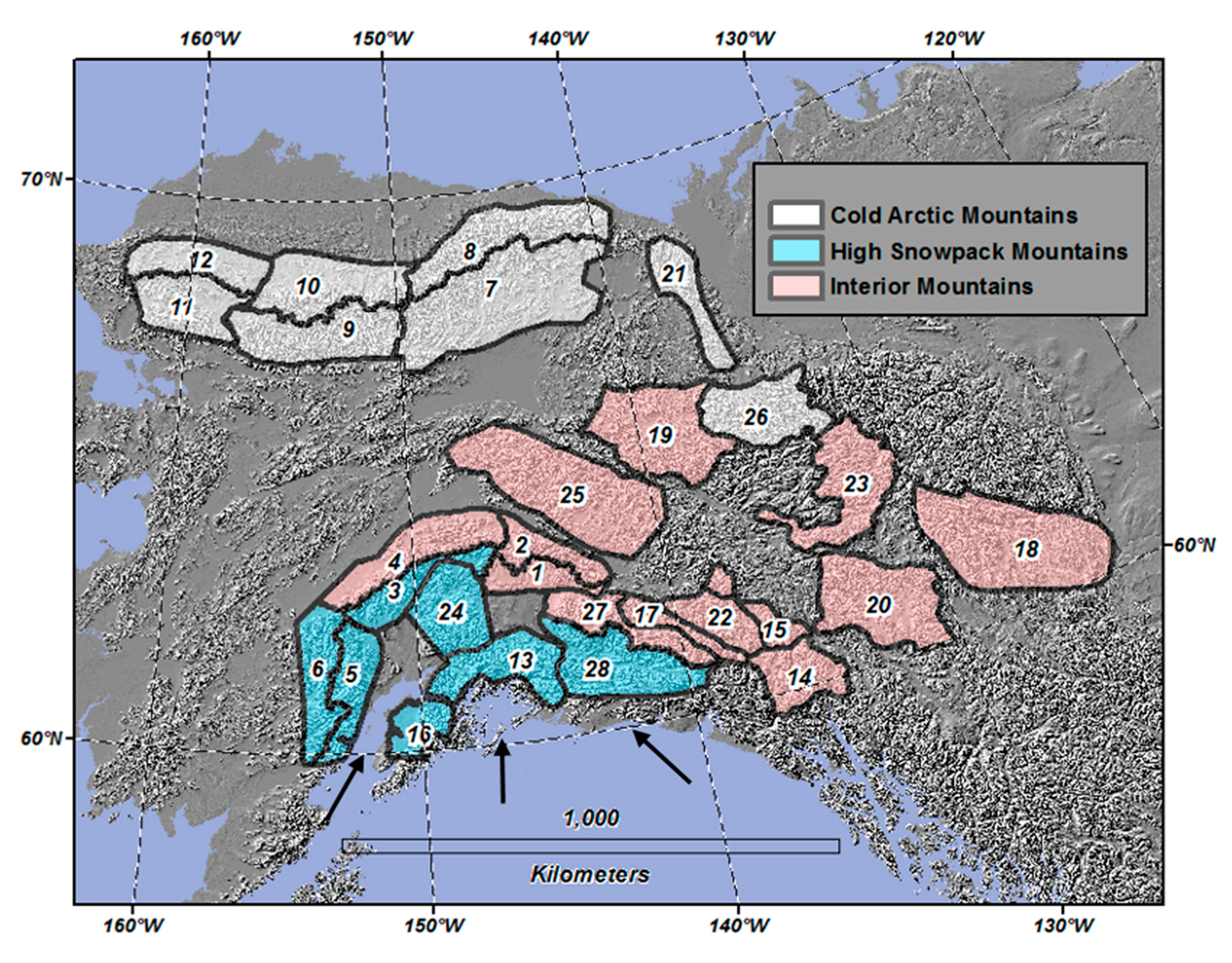
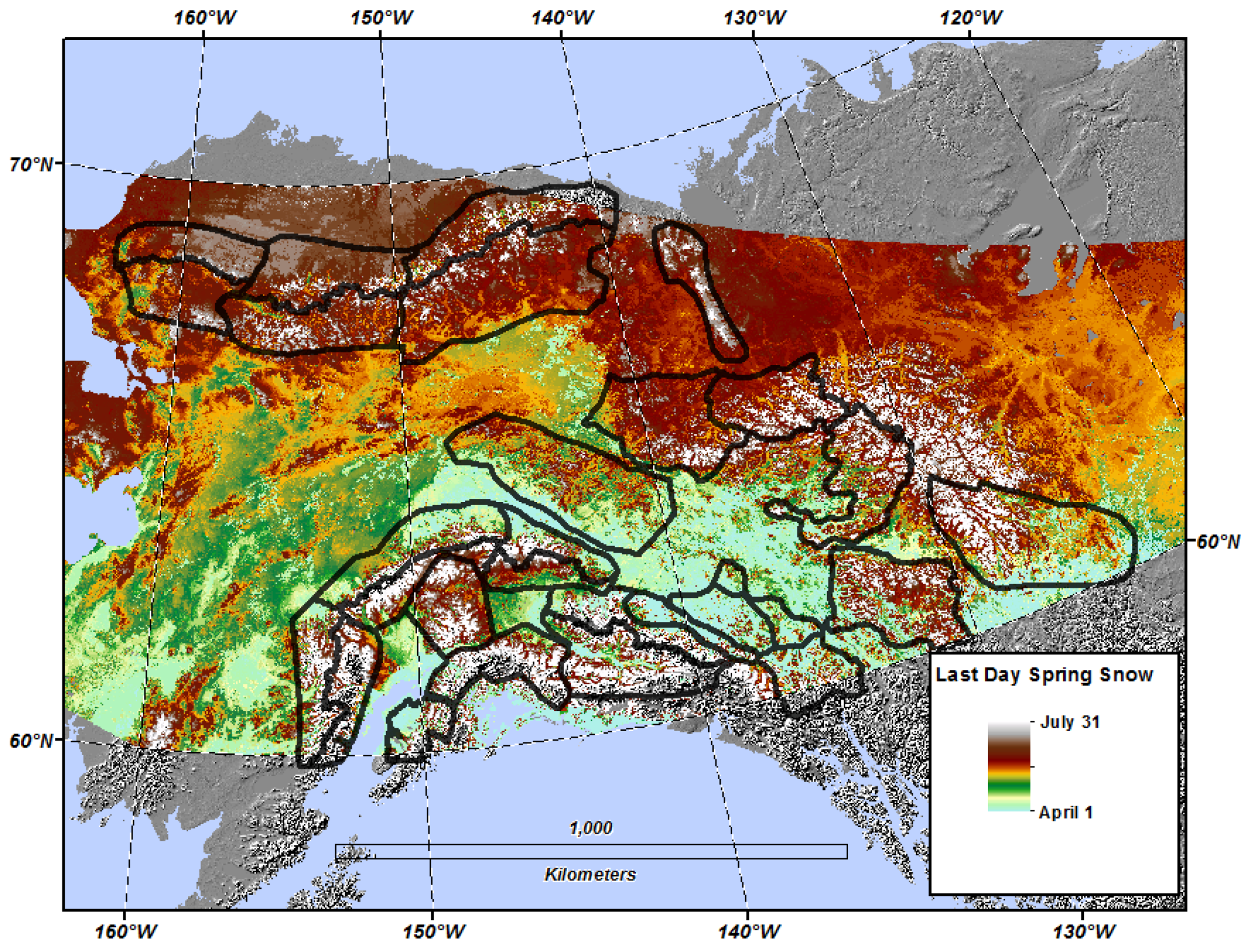

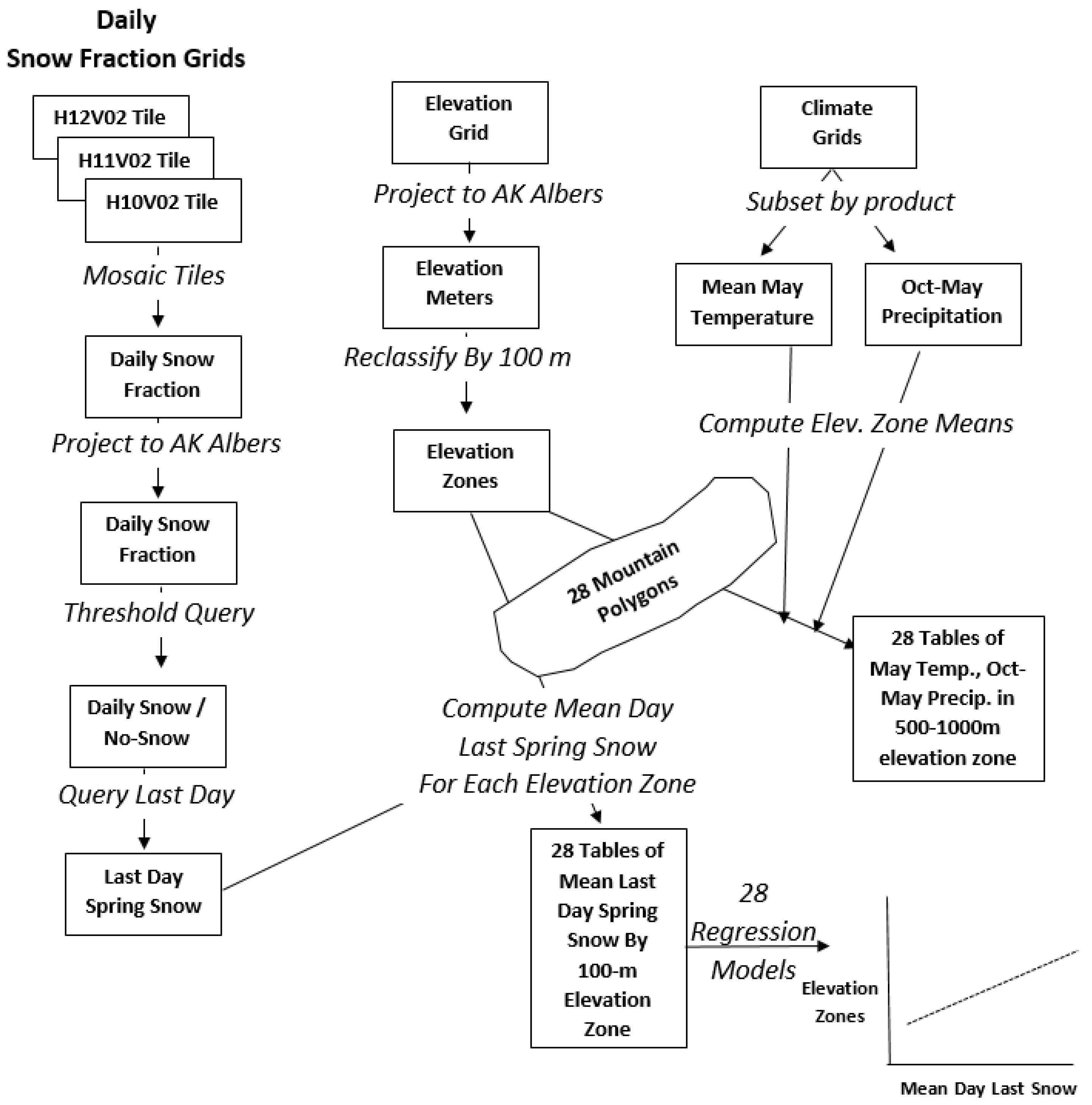
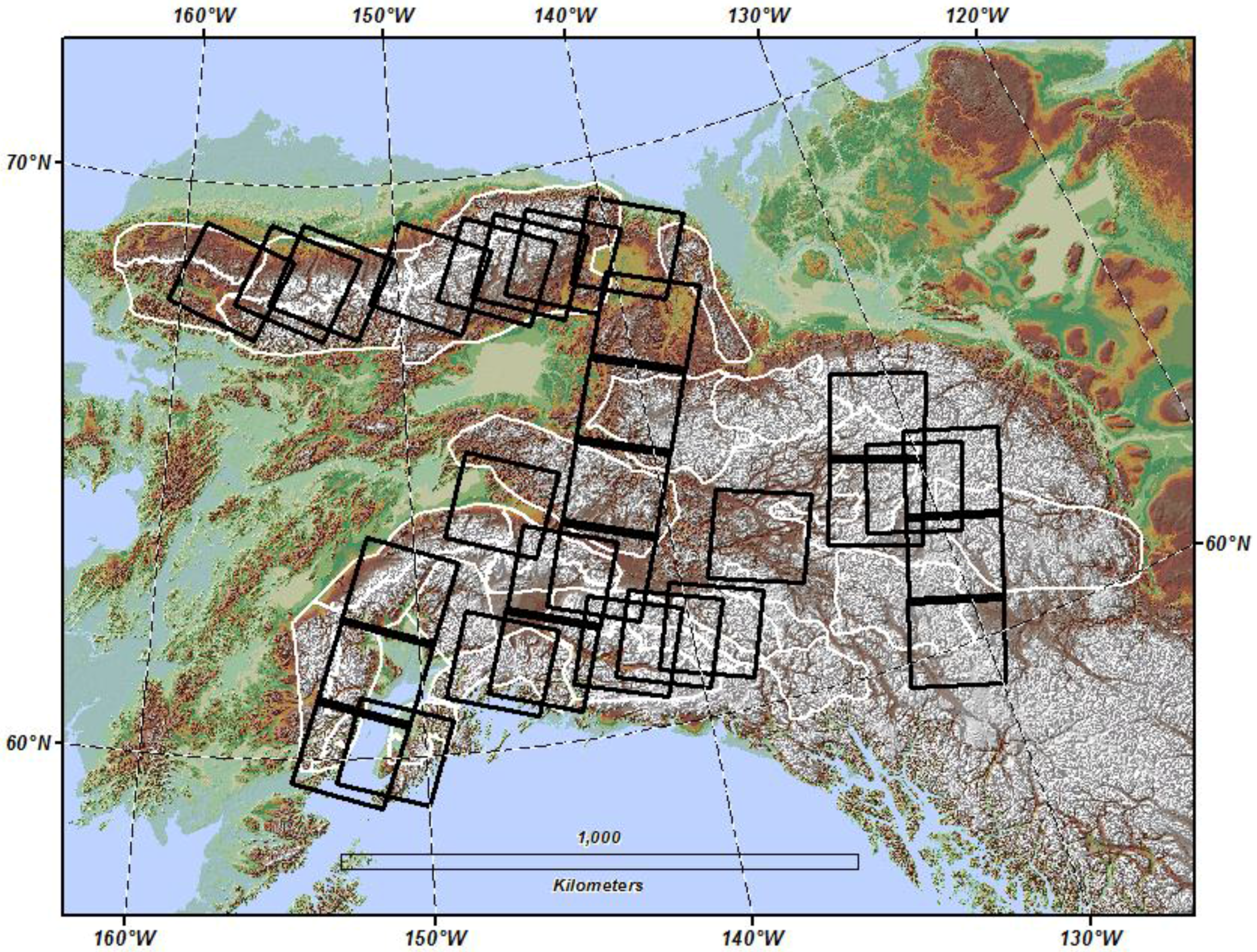


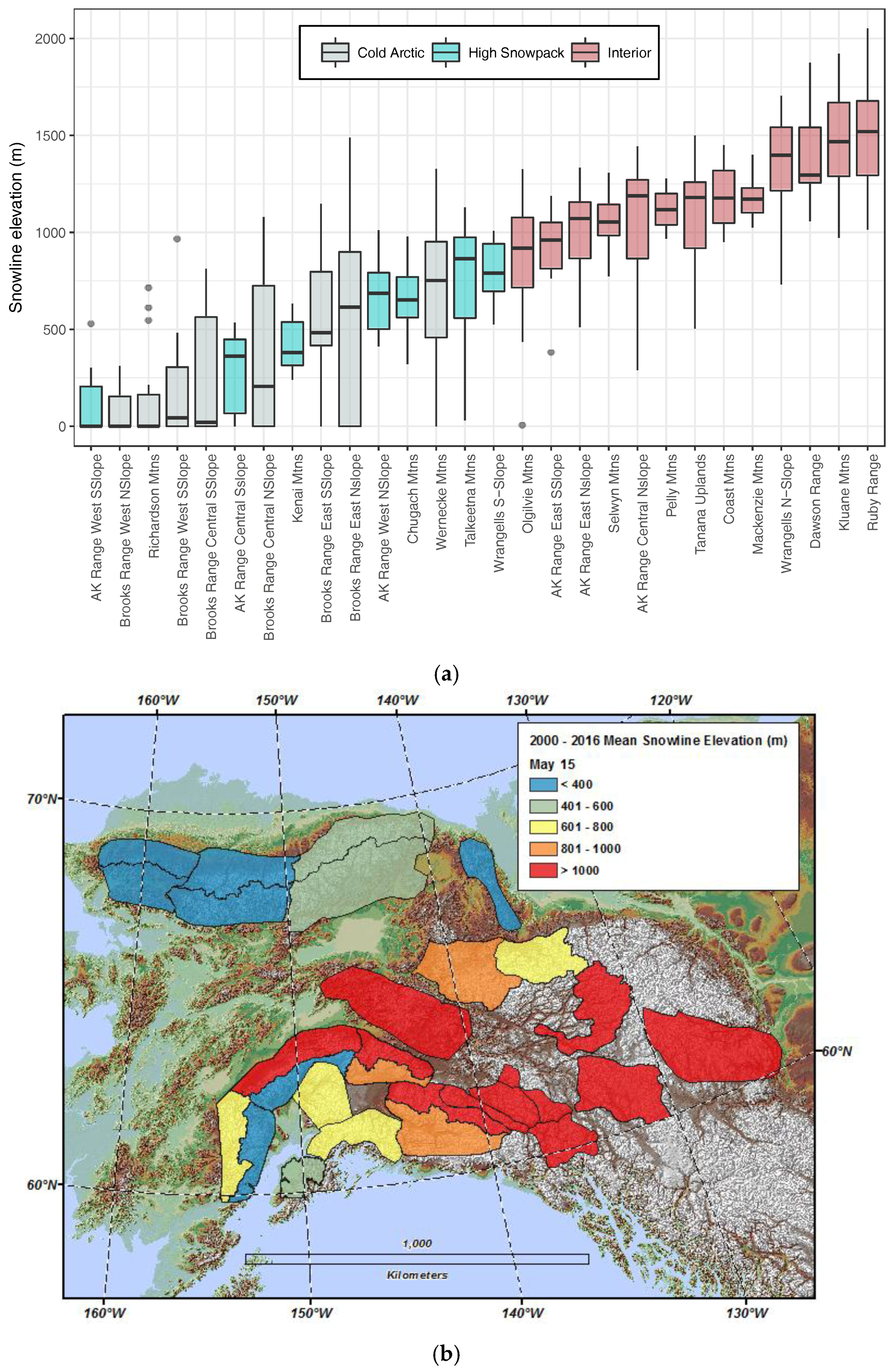
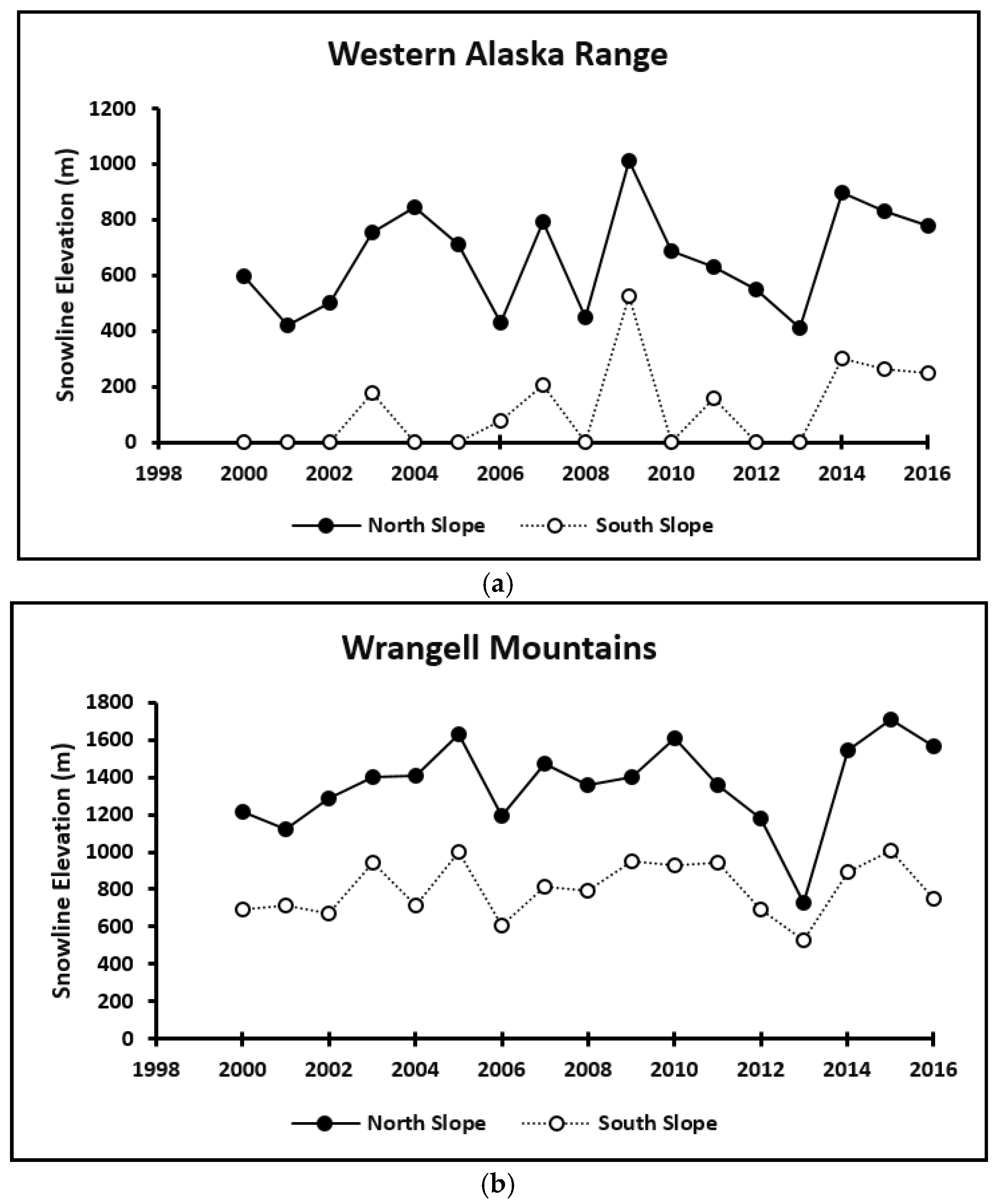
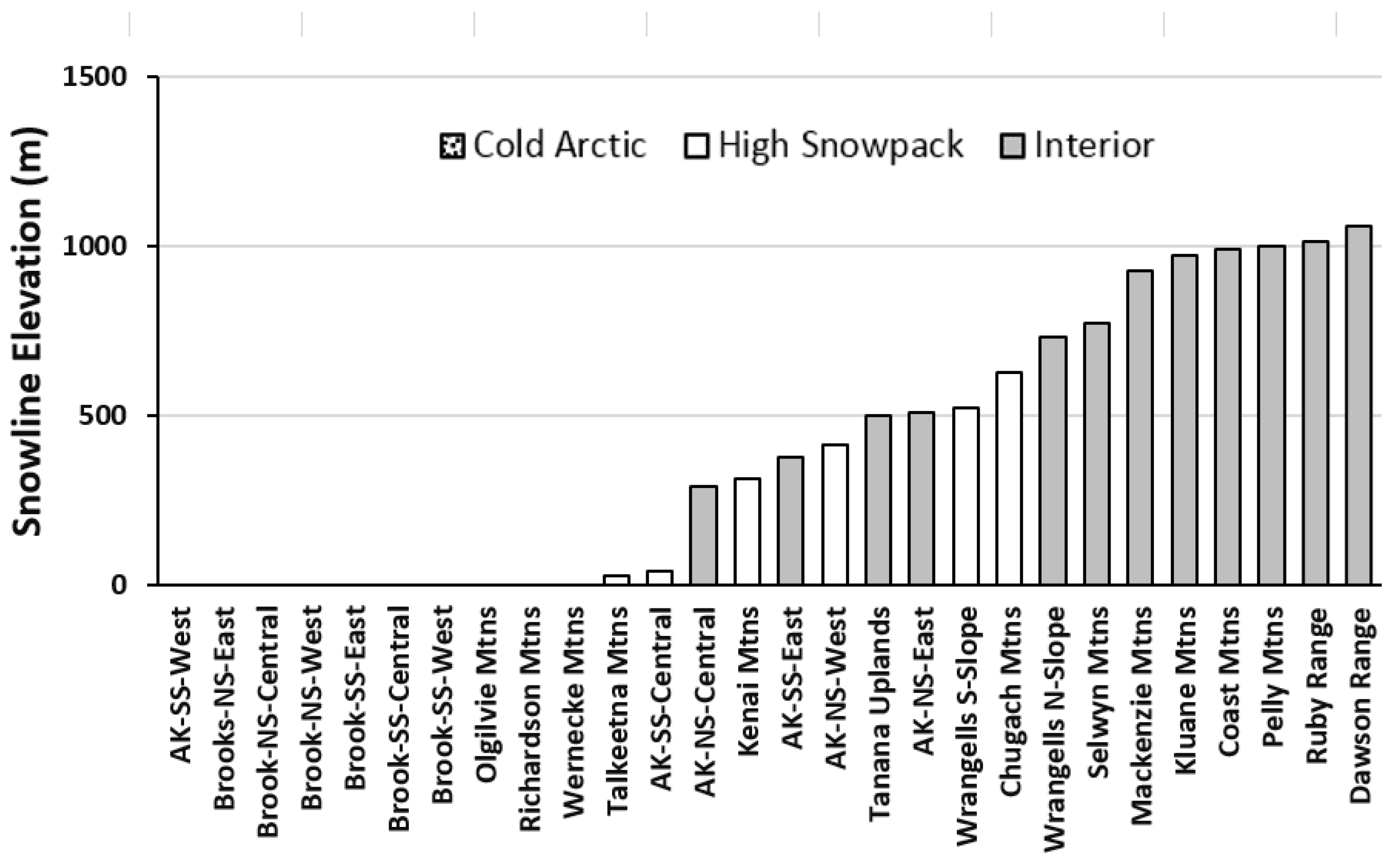
| Mountain Area | Area km2 | Elevation Range (m) | Mean May Temp. (°C) | Total Winter Precip. (mm) | Climatic Class |
|---|---|---|---|---|---|
| (1) Alaska Range East, South Slope | 12,177 | 500–2500 | 5.2 | 124 | Interior |
| (2) Alaska Range East, North Slope | 13,284 | 300–2500 | 6.6 | 112 | Interior |
| (3) Alaska Range Central, South Slope | 15,314 | 50–2500 | 4.8 | 442 | High Snowpack |
| (4) Alaska Range Central, North Slope | 28,124 | 100–2500 | 6.7 | 145 | Interior |
| (5) Alaska Range West, South Slope | 18,583 | 0–2500 | 4.8 | 936 | High Snowpack |
| (6) Alaska Range West, North Slope | 21,181 | 0–2500 | 5.8 | 458 | High Snowpack |
| (7) Brooks Range East, South Slope | 65,367 | 200–2400 | 3.8 | 64 | Cold Arctic |
| (8) Brooks Range East, North Slope | 32,698 | 50–2500 | 0.2 | 83 | Cold Arctic |
| (9) Brooks Range Central, South Slope | 33,797 | 50–2300 | 2.0 | 185 | Cold Arctic |
| (10) Brooks Range Central, North Slope | 31,667 | 100–2200 | −0.1 | 156 | Cold Arctic |
| (11) Brooks Range West, South Slope | 23,367 | 50–1500 | 1.8 | 248 | Cold Arctic |
| (12) Brooks Range West, North Slope | 20,311 | 150–1400 | 0.1 | 235 | Cold Arctic |
| (13) Chugach Mountains | 23,937 | 0–2500 | 4.7 | 807 | High Snowpack |
| (14) Coast Mountains | 18,688 | 350–2350 | 5.8 | 254 | Interior |
| (15) Dawson Range, | 9715 | 600–2000 | 6.2 | 113 | Interior |
| (16) Kenai Mountains | 11,317 | 0–1900 | 7.6 | 914 | High Snowpack |
| (17) Kluane Mountains | 9342 | 500–2500 | 5.5 | 112 | Interior |
| (18) Mackenzie Mountains | 60,535 | 200–2700 | 5.8 | 232 | Interior |
| (19) Olgilvie Mountains | 39,956 | 200–2200 | 5.2 | 125 | Interior |
| (20) Pelly Mountains | 39,118 | 600–2300 | 5.7 | 185 | Interior |
| (21) Richardson Mountains | 17,099 | 150–1700 | 3.0 | 161 | Interior |
| (22) Ruby Range | 14,256 | 600–2300 | 6.4 | 116 | Interior |
| (23) Selwyn Mountains | 33,511 | 500–2500 | 5.9 | 215 | Interior |
| (24) Talkeetna Mountains | 22,634 | 100–2500 | 5.1 | 326 | High Snowpack |
| (25) Tanana Uplands | 60,034 | 150–1900 | 7.0 | 84 | Interior |
| (26) Wernecke Mountains | 27,722 | 350–2500 | 4.0 | 174 | Cold Arctic |
| (27) Wrangell Mountains, North Slope | 18,895 | 500–2500 | 6.6 | 100 | Interior |
| (28) Wrangell Mountains, South Slope | 32,994 | 50–2500 | 6.3 | 480 | High Snowpack |
| Coefficient | Std. Error | p-Value | |
|---|---|---|---|
| Intercept | 337.96 | 117.53 | 0.00812 |
| May temperature (°C) | 148.36 | 22.032 | <0.0001 |
| Winter Precip (mm) | −0.9837 | 0.1934 | <0.0001 |
© 2017 by the authors. Licensee MDPI, Basel, Switzerland. This article is an open access article distributed under the terms and conditions of the Creative Commons Attribution (CC BY) license (http://creativecommons.org/licenses/by/4.0/).
Share and Cite
Verbyla, D.; Hegel, T.; Nolin, A.W.; Van de Kerk, M.; Kurkowski, T.A.; Prugh, L.R. Remote Sensing of 2000–2016 Alpine Spring Snowline Elevation in Dall Sheep Mountain Ranges of Alaska and Western Canada. Remote Sens. 2017, 9, 1157. https://doi.org/10.3390/rs9111157
Verbyla D, Hegel T, Nolin AW, Van de Kerk M, Kurkowski TA, Prugh LR. Remote Sensing of 2000–2016 Alpine Spring Snowline Elevation in Dall Sheep Mountain Ranges of Alaska and Western Canada. Remote Sensing. 2017; 9(11):1157. https://doi.org/10.3390/rs9111157
Chicago/Turabian StyleVerbyla, David, Troy Hegel, Anne W. Nolin, Madelon Van de Kerk, Thomas A. Kurkowski, and Laura R. Prugh. 2017. "Remote Sensing of 2000–2016 Alpine Spring Snowline Elevation in Dall Sheep Mountain Ranges of Alaska and Western Canada" Remote Sensing 9, no. 11: 1157. https://doi.org/10.3390/rs9111157




